Facilities
Experimental facilities
Large world-class experimental facilities possessed by the Department of Aeronautics & Astronautics are utilised to gain physical insights into high-speed flowfields and high-temperature phenomena and verify the results from numerical simulation and design optimisation.
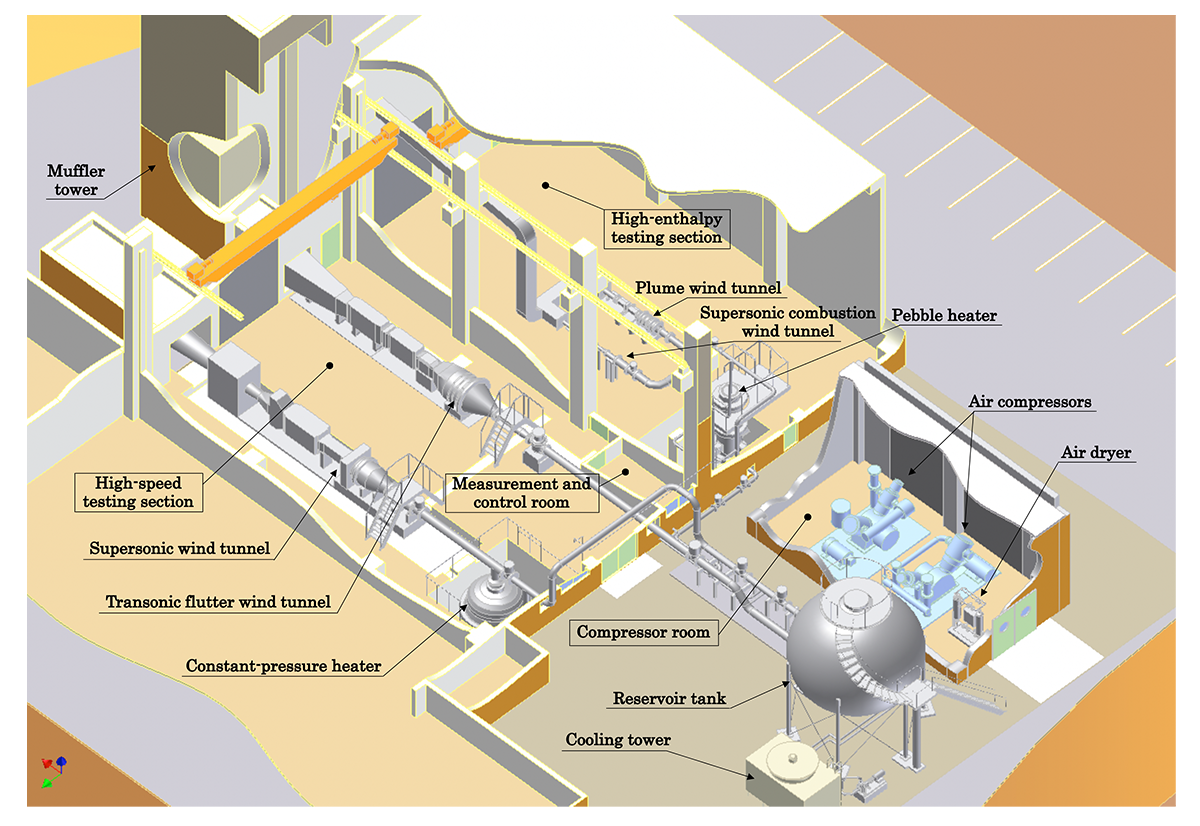
High-speed and high-enthalpy wind tunnels (bird’s-eye view)
High-speed wind tunnels
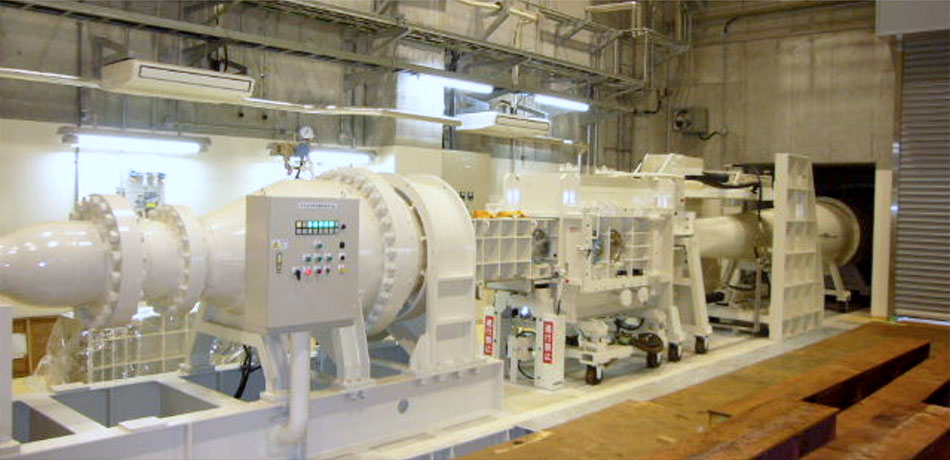
Supersonic wind tunnel
The supersonic wind tunnel can produce high-speed airflow that can reproduce the flow conditions of aircraft and their elements, e.g., wings, or other objects flying at supersonic speeds (Mach 2.5 and 3.5 nozzles are available at present). The constant-pressure heater can increase the total temperature of the air inflow up to 573 K.
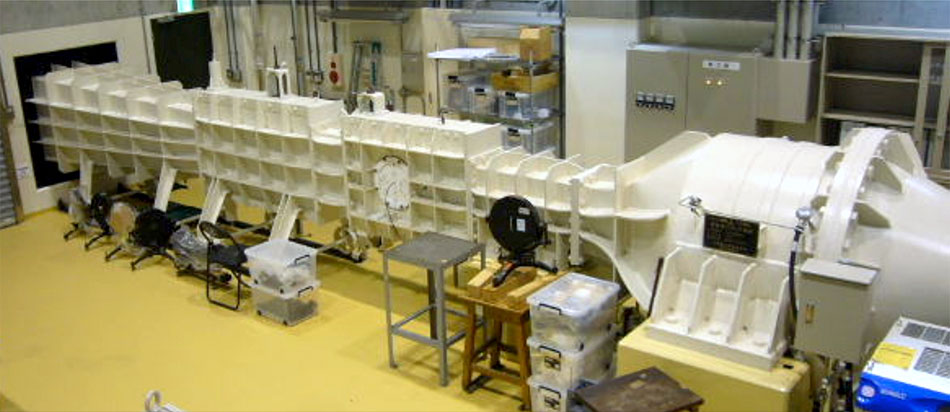
Transonic flutter wind tunnel
The transonic flutter wind tunnel is capable of generating airflow that can reproduce transonic aerodynamic phenomena including shock waves and shock-wave/boundary-layer interaction. It is also suitable to investigate aeroelastic behaviour and fluid-structure interactions such as wing flutter that can occur as a result of cross-disciplinary coupling.
| Supersonic wind tunnel | Transonic flutter wind tunnel | |
|---|---|---|
| Mach number | 2.5 / 3.5 | 0.4 / 1.0 / 1.3 |
| Total pressure | 0.37 MPa @ M = 2.5 1.27 MPa @ M = 3.5 |
0.11 MPa @ M = 0.4 0.13 MPa @ M = 1.0 0.15 MPa @ M = 1.3 |
| Total temperature | ~293 K @ M = 2.5 573 K @ M = 3.5 |
~293 K (room temperature) |
| Test section size (W×H) | 200 mm×250 mm | 250 mm×450 mm |
| Run time | 85 sec @ M = 2.5 50 sec @ M = 3.5 |
95 sec @ M = 0.4 40 sec @ M = 1.3 |
| Type | Blow down type | Blow down type |
High-enthalpy wind tunnels

Supersonic combustion wind tunnel (left) and Plume wind tunnel (right)
The supersonic combustion wind tunnel can produce high-temperature flow at Mach 2 for approximately 10 seconds. The total temperature of the airflow can be increased up to 1900 K by the pebble heater, rendering it particularly suitable for supersonic combustion testing for scramjet engines using hydrogen fuel.
The plume wind tunnel can be used to investigate the jet behaviour and interaction effects of the rocket plume gas and other exhaust gases.
| Supersonic combustion wind tunnel | Plume wind tunnel | |
|---|---|---|
| Mach number | 2.0 | 0.41 |
| Total pressure | 0.7 MPa (ave) | 0.11 MPa |
| Total temperature | 1400 ~ 1900 K | − |
| Test section size (W×H) | 40 mm×40 mm | 140 mm×140 mm |
| Run time | 10 sec | 3 min |
| Type | Blow down type | Blow down type |
Computational facilities
Hybrid workstation 1

Hybrid workstation 1
A high-performance hybrid workstation with 56 CPU cores and two Quadro GV100 GPU cards (sponsored by Kyushu University School of Engineering) boasting double-precision performance of 7.4 Tflops is utilised as the primary machine for multi-fidelity hybrid computation as well as high-fidelity simulation (while larger-scale computations are performed on high-performance computing clusters or supercomputers available at Kyushu University or research partners).
| CPU | 56 cores (Intel Xeon Platinum) |
|---|---|
| GPU | NVIDIA Quadro GV100 with 48 GB 5120 cores × 2 (Volta architecture) with NVLink bridge (FP32: 14.8 Tflops / FP64: 7.4 Tflops) |
| Memory | 512 GB (8 × 64 GB) |
| Storage | 30 TB (6 TB SSD + 24 TB HDD) |
Hybrid workstation 2
Another hybrid workstation with 44 CPU cores and two NVIDIA Quadro P6000 (3840 GPU cores each) is used as the second machine mainly for multi-fidelity hybrid computation as well as high-fidelity simulation.
| CPU | 44 cores (Intel Xeon Gold) |
|---|---|
| GPU | NVIDIA Quadro P6000 with 24 GB 3840 cores × 2 (Pascal architecture) (FP32: 12.6 Tflops / FP64: 395 Gflops) |
| Memory | 64 GB (4 × 16 GB) |
| Storage | 1 TB (HP Z Turbo Drive M.2) |
Hybrid workstations 3 & 4
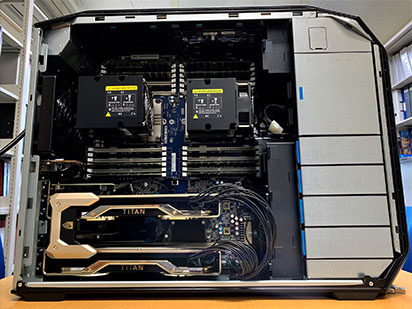
Hybrid workstations 3 & 4
Two HP Z8 workstations equipped with a 16 CPU-core Intel Xeon processor and two NVIDIA RTX Titan GPU cards each (two of which funded by JAXA) are available mainly for multi-fidelity hybrid computation as well as high-fidelity simulation.
| CPU | 16 cores (Intel Xeon Silver) |
|---|---|
| GPU | NVIDIA GeForce RTX Titan with 24 GB 4608 cores × 2 (Turing architecture) with NVLink bridge (FP32: 16.3 Tflops / FP64: 510 Gflops) |
| Memory | 160 GB (4 ×8 + 4 ×32 GB) |
| Storage | 2.5 TB (512 GB HP Z Turbo Drive M.2 + 2 TB HDD) |
Multi-purpose workstation
An iMac Pro equipped with an 18 CPU-core Intel Xeon processor is used as a multi-purpose workstation primarily for multi-objective optimisation incorporating high-fidelity simulation as well as post processing of the results.
| CPU | 18 cores (Intel Xeon with Turbo Boost) |
|---|---|
| GPU | AMD Radeon Pro Vega 64 with 16 GB 4096 cores (GCN 5.0 architecture) (FP32: 11.1 Tflops / FP64: 691 Gflops) |
| Memory | 128 GB (8 ×16 GB) |
| Storage | 2 TB SSD |
Laboratory
Laboratory 1
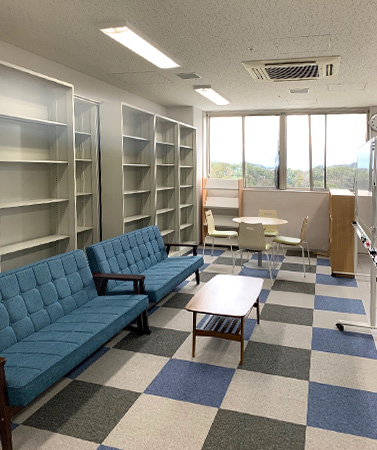
Meeting/reading area of STSEL Laboratory 1
Our main laboratory consists of two areas, i.e., meeting/reading area (in the photo) and working space, along with an adjacent experiment room. Our lab is equipped with furniture to maximise the productivity and inspiration. It is primarily used for the Space projects.
Laboratory 2
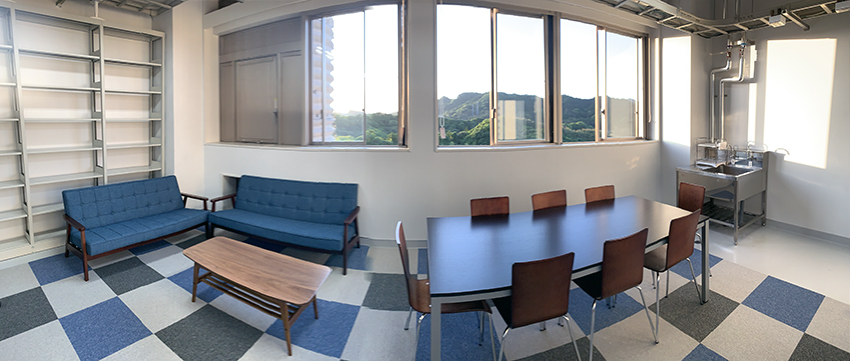
Project/meeting area of STSEL Laboratory 2
Acquired recently, our second laboratory features a project/meeting area (in the photo) and working space, equipped with new furniture. It is primarily used for the Hypersonics projects. Both labs are located on the top level (8th floor) of the building, commanding a nice view of Ito Peninsula and beautiful sunset.


